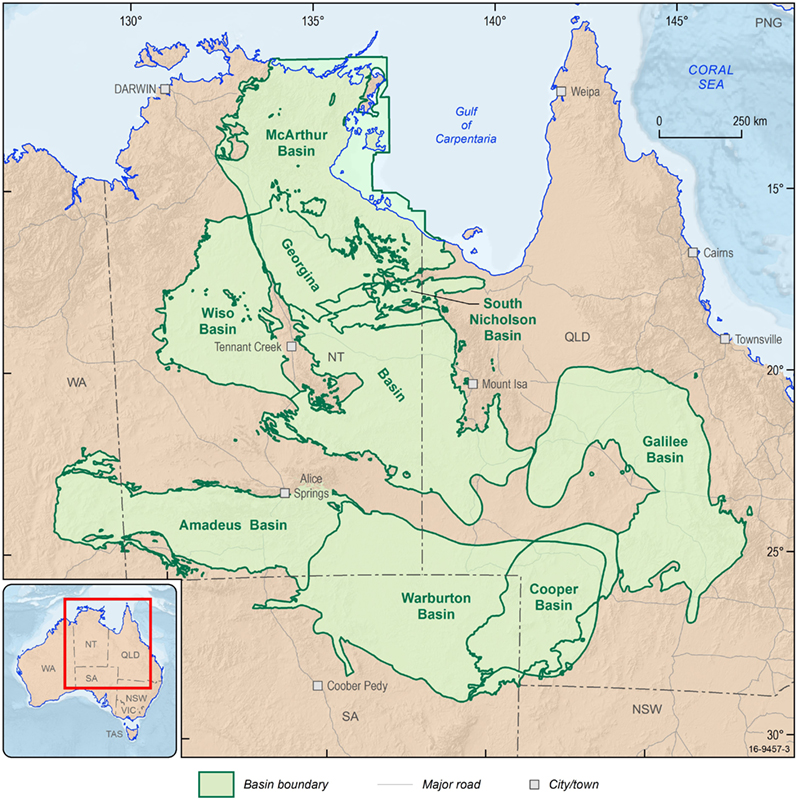Amadeus Basin Prospectivity Study
Last updated:7 June 2023
Overview
The Amadeus Basin in central Australia contains commercial petroleum fields and has the potential to host undiscovered resources. Current production is from the highly prospective early Paleozoic Larapintine Petroleum Supersystem of Bradshaw (1993) from the Ordovician reservoirs in the Mereenie oil and gas field, the Palm Valley gas field and until recently, the Surprise oil field (Heugh et al 2012), in addition to the Neoproterozoic Dingo gas field. Despite this production, most of the greater Amadeus Basin is largely considered to be a greenfields basin with only 38 petroleum wells drilled (Marshall, 2005; Munson, 2014). The majority of exploration drilling has been undertaken near the Central Ridge and has focused on Ordovician plays where source rocks, presumably within the Horn Valley Siltstone, have generated and expelled petroleum into reservoirs within the Pacoota and Stairway sandstones (Korsch and Kennard, 1991, Fig. 2).
The granting of licenses for the construction of a gas pipeline to the east coast of Australia (Onshoregas, 2016) has focused new interest in the Amadeus Basin for both conventional and unconventional petroleum exploration and production (Carr et al., 2016). The discovery of light sweet crude in Surprise 1 by Central Petroleum is evidence that the Horn Valley Siltstone contains an abundance of both oil and gas reserves (Munson, 2014). Furthermore, in the southwestern part of the basin, helium-rich gas has been discovered in the Tonian Heavitree Quartzite at Magee 1 (6 mol% He: Palmer and Ambrose, 2012, Wakelin-King and Austin, 1992) and Mt Kitty 1 (5.8 mol% He: Palmer and Ambrose, 2012.
The Onshore Energy Systems Section at Geoscience Australia is currently undertaking a comprehensive geochemical study of the Amadeus Basin. One component of the study is the Australian Source Rocks Mapping Project, in which newly acquired and legacy total organic carbon (TOC) and Rock-Eval pyrolysis screening data are used to determine the distribution, type, quality, maturity and generation potential of source rocks in the basin. The second component of this study uses molecular (biomarker) and compound-specific stable carbon and hydrogen isotopic analysis to conduct gas-oil and oil-source rock correlations to better define the basin's petroleum systems.
Conference presentations, posters and papers
- Jarrett, A.J.M., Edwards, D.S., Boreham, C.J. & McKirdy, D.M., 2016. Petroleum Geochemistry of the Amadeus Basin. Extended abstract and oral presentation at the Northern Territory AGES conference, 15-16 March 2016, Alice Springs, Australia.
- Boreham, C.J. Edwards, D.S. and Poreda, R.J., 2016. Helium isotopic distribution of Australian natural gases. Abstract and oral presentation at the Australian Organic Geochemistry Conference, 4-7 December 2016, Fremantle, Australia
References
- Bradshaw, M.T., 1993. Australian Petroleum Systems. PESA Journal, No.21, 43-53.
- Heugh, J.P., Askin, H., Dunmorem W., Ambrose, G.J., Shortt, T., Hallgren, D., Alamiyo, B.O., Sayers, J. and Boreham, C., 2012. Petroleum geoscience of the Surprise oil field in the western Amadeus Basin; implications for regional exploration. Central Australian Basins Symposium III, Alice Springs, NT, 16-17 July 2012. Petroleum Exploration Society of Australia Special Publication, 1-10.
- Korsch, R.J. and Kennard, J.M. (Eds) 1991. Geological and geophysical studies in the Amadeus Basin, Central Australia.
- Marshall, T.R., 2005. A review of source rocks in the Amadeus Basin. Northern Territory Geological Survey, Record 2004-008.
- Munson, T.J., 2014. Petroleum geology and potential of the onshore Northern Territory, 2014, Northern Territory Geological Survey, Report 2014-022
- Palmer, N. and Ambrose, G., 2012. Mount Kitty Prospect, southern Amadeus Basin. In: Ambrose, G., Scott, J. (Ed.), Central Australian Basins Symposium III, Petroleum Exploration Society of Australia Special Publication.
- Wakelin-King, G. and Austin, L., 1992. Magee 1, EP 38, Northern Territory, Well completion report. Pacific Oil and Gas Ltd. Northern Territory Geological Survey, Open File Petroleum Report PR1992-0121.
